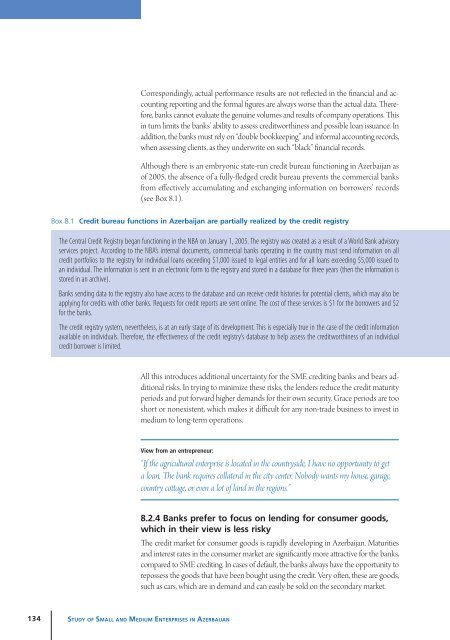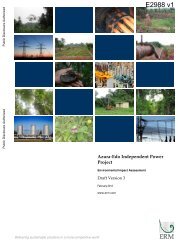Study of Small and Medium Enterprises in Azerbaijan - IFC
Study of Small and Medium Enterprises in Azerbaijan - IFC
Study of Small and Medium Enterprises in Azerbaijan - IFC
You also want an ePaper? Increase the reach of your titles
YUMPU automatically turns print PDFs into web optimized ePapers that Google loves.
Correspond<strong>in</strong>gly, actual performance results are not reflected <strong>in</strong> the f<strong>in</strong>ancial <strong>and</strong> account<strong>in</strong>g<br />
report<strong>in</strong>g <strong>and</strong> the formal figures are always worse than the actual data. Therefore,<br />
banks cannot evaluate the genu<strong>in</strong>e volumes <strong>and</strong> results <strong>of</strong> company operations. This<br />
<strong>in</strong> turn limits the banks’ ability to assess creditworth<strong>in</strong>ess <strong>and</strong> possible loan issuance. In<br />
addition, the banks must rely on “double bookkeep<strong>in</strong>g” <strong>and</strong> <strong>in</strong>formal account<strong>in</strong>g records,<br />
when assess<strong>in</strong>g clients, as they underwrite on such “black” f<strong>in</strong>ancial records.<br />
Although there is an embryonic state-run credit bureau function<strong>in</strong>g <strong>in</strong> <strong>Azerbaijan</strong> as<br />
<strong>of</strong> 2005, the absence <strong>of</strong> a fully-fledged credit bureau prevents the commercial banks<br />
from effectively accumulat<strong>in</strong>g <strong>and</strong> exchang<strong>in</strong>g <strong>in</strong>formation on borrowers’ records<br />
(see Box 8.1).<br />
Box 8.1 Credit bureau functions <strong>in</strong> <strong>Azerbaijan</strong> are partially realized by the credit registry<br />
The Central Credit Registry began function<strong>in</strong>g <strong>in</strong> the NBA on January 1, 2005. The registry was created as a result <strong>of</strong> a World Bank advisory<br />
services project. Accord<strong>in</strong>g to the NBA’s <strong>in</strong>ternal documents, commercial banks operat<strong>in</strong>g <strong>in</strong> the country must send <strong>in</strong>formation on all<br />
credit portfolios to the registry for <strong>in</strong>dividual loans exceed<strong>in</strong>g $1,000 issued to legal entities <strong>and</strong> for all loans exceed<strong>in</strong>g $5,000 issued to<br />
an <strong>in</strong>dividual. The <strong>in</strong>formation is sent <strong>in</strong> an electronic form to the registry <strong>and</strong> stored <strong>in</strong> a database for three years (then the <strong>in</strong>formation is<br />
stored <strong>in</strong> an archive).<br />
Banks send<strong>in</strong>g data to the registry also have access to the database <strong>and</strong> can receive credit histories for potential clients, which may also be<br />
apply<strong>in</strong>g for credits with other banks. Requests for credit reports are sent onl<strong>in</strong>e. The cost <strong>of</strong> these services is $1 for the borrowers <strong>and</strong> $2<br />
for the banks.<br />
The credit registry system, nevertheless, is at an early stage <strong>of</strong> its development. This is especially true <strong>in</strong> the case <strong>of</strong> the credit <strong>in</strong>formation<br />
available on <strong>in</strong>dividuals. Therefore, the effectiveness <strong>of</strong> the credit registry’s database to help assess the creditworth<strong>in</strong>ess <strong>of</strong> an <strong>in</strong>dividual<br />
credit borrower is limited.<br />
All this <strong>in</strong>troduces additional uncerta<strong>in</strong>ty for the SME credit<strong>in</strong>g banks <strong>and</strong> bears additional<br />
risks. In try<strong>in</strong>g to m<strong>in</strong>imize these risks, the lenders reduce the credit maturity<br />
periods <strong>and</strong> put forward higher dem<strong>and</strong>s for their own security. Grace periods are too<br />
short or nonexistent, which makes it difficult for any non-trade bus<strong>in</strong>ess to <strong>in</strong>vest <strong>in</strong><br />
medium to long-term operations.<br />
View from an entrepreneur:<br />
“If the agricultural enterprise is located <strong>in</strong> the countryside, I have no opportunity to get<br />
a loan. The bank requires collateral <strong>in</strong> the city center. Nobody wants my house, garage,<br />
country cottage, or even a lot <strong>of</strong> l<strong>and</strong> <strong>in</strong> the regions.”<br />
8.2.4 Banks prefer to focus on lend<strong>in</strong>g for consumer goods,<br />
which <strong>in</strong> their view is less risky<br />
The credit market for consumer goods is rapidly develop<strong>in</strong>g <strong>in</strong> <strong>Azerbaijan</strong>. Maturities<br />
<strong>and</strong> <strong>in</strong>terest rates <strong>in</strong> the consumer market are significantly more attractive for the banks,<br />
compared to SME credit<strong>in</strong>g. In cases <strong>of</strong> default, the banks always have the opportunity to<br />
repossess the goods that have been bought us<strong>in</strong>g the credit. Very <strong>of</strong>ten, these are goods,<br />
such as cars, which are <strong>in</strong> dem<strong>and</strong> <strong>and</strong> can easily be sold on the secondary market.<br />
134<br />
St u d y o f Sma l l a n d Me d i u m Ent e r p r i s es <strong>in</strong> Az e r b a i j a n

















